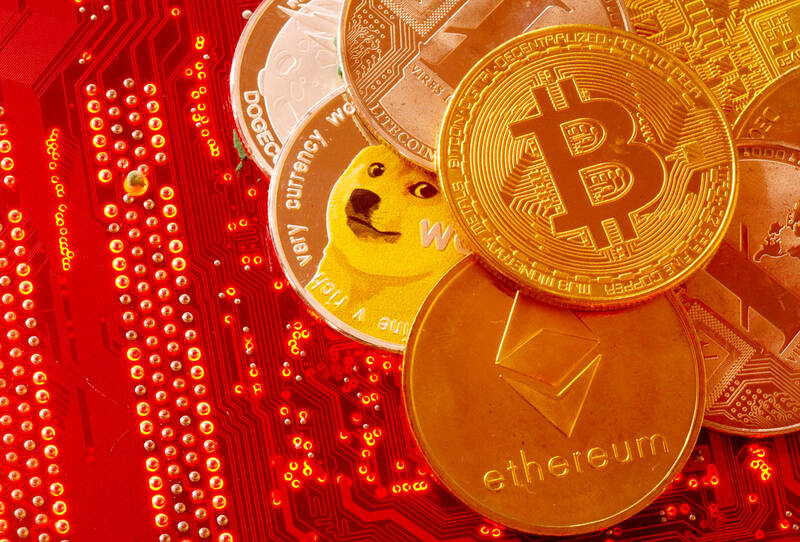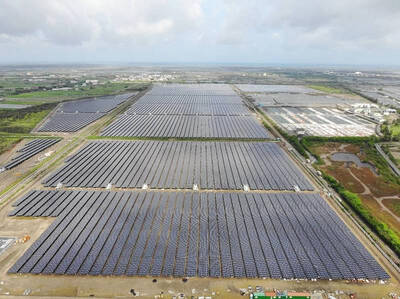The biggest software upgrade in the short history of crypto has fulfilled its promise to wipe out more than 99 percent of the electricity used by the second-biggest cryptocurrency, experts have said.
That is no mean feat, given that the Ethereum blockchain was burning through about as much electricity as New Zealand.
Sceptics had expected glitches with the upgrade, known as “the merge,” but it ended up being a “rather boring event,” according to Alex de Vries of the Free University in Amsterdam. De Vries, whose Digiconomist Web site models the energy use of Bitcoin and Ethereum, said consumption had indeed plummeted by more than 99 percent on Ethereum.

Photo: REUTERS
Moritz Platt, a researcher specializing in crypto at King’s College London, said the 99 percent estimates were realistic and heralded a positive step towards “cryptocurrency sustainability.”
So the Ethereum blockchain, which supports billions of dollars of trading in games, tokens, art and the ether currency, has cleaned up its act. But there are complications.
Ethereum faces bitter opposition from those who lost out from the merge and it could also get greater scrutiny from regulators.
‘ASTRONOMICAL GROWTH’
The old system, known as “proof of work,” relied on people and firms to “mine” new coins — an industry worth US$22 million daily before the merge, according to de Vries. The miners used vast power-guzzling computer rigs to compete with each other to solve complex equations, and the winner was awarded the prize of adding entries to the blockchain and generating coins. The merge wiped out their business model overnight.
“Those rigs do not magically turn back into invested capital,” said a crypto-miner known only as “J” who operates between Singapore and Hong Kong. He said it was costing him between US$30,000 and US$40,000 a month to keep his staff and equipment idling while he thinks about his next move.
Plenty of miners have sold off their kit, while others are putting their rigs to work on less profitable blockchains that still use the old system. A miner who uses the name Leon Ravencoin, for example, has been tweeting non-stop about the “astronomical” growth of Ravencoin, one of the currencies to get a boost after the merge.
The combined computing power used by these coins is around one-fifth of the pre-merge Ethereum blockchain. However, de Vries said they generated only about US$500,000 in daily revenue so only the most energy-efficient machines with the lowest energy costs would be able to make a profit.
As a result, one-fifth of the computing power would work out far less than one-fifth of the electricity use.
‘DESIGNED TO BE CENTRALIZED’
Aside from the problem with miners, the new system, known as “proof of stake,” has several issues baked in.
Anyone willing to stake a large amount of ether can now “validate” new entries on the blockchain.
The more you stake, the more chance you have of updating the chain and earning coins. The system gives an advantage to the biggest players, and just three companies now account for more than half of “validators,” according to research by Dune Analytics. Cryptocurrencies were envisaged as a decentralized alternative to the banks, corporations and governments that failed so spectacularly during the global crash of 2008.
But crypto-miner J said the new Ethereum was “designed to be more centralized” and suggested it no longer had a real purpose.
Regulators have also begun to pay attention, with US Securities and Exchange Commission Chairman Gary Gensler suggesting proof-of-stake looked like a securities market that would fall under his remit.
The disaster scenario for Ethereum would be that enough disgruntled purists switch to one of the gas-guzzling proof-of-work alternatives, with Ethereum Classic being the main one.
“There is nothing capping Ethereum Classic prices,” said de Vries, meaning that miners could potentially make good profits if the market shifted their way.
A rush from the greener blockchain was “theoretically definitely possible,” he said.

In recent weeks the Trump Administration has been demanding that Taiwan transfer half of its chip manufacturing to the US. In an interview with NewsNation, US Secretary of Commerce Howard Lutnick said that the US would need 50 percent of domestic chip production to protect Taiwan. He stated, discussing Taiwan’s chip production: “My argument to them was, well, if you have 95 percent, how am I gonna get it to protect you? You’re going to put it on a plane? You’re going to put it on a boat?” The stench of the Trump Administration’s mafia-style notions of “protection” was strong

Every now and then, it’s nice to just point somewhere on a map and head out with no plan. In Taiwan, where convenience reigns, food options are plentiful and people are generally friendly and helpful, this type of trip is that much easier to pull off. One day last November, a spur-of-the-moment day hike in the hills of Chiayi County turned into a surprisingly memorable experience that impressed on me once again how fortunate we all are to call this island home. The scenery I walked through that day — a mix of forest and farms reaching up into the clouds

With one week left until election day, the drama is high in the race for the Chinese Nationalist Party (KMT) chair. The race is still potentially wide open between the three frontrunners. The most accurate poll is done by Apollo Survey & Research Co (艾普羅民調公司), which was conducted a week and a half ago with two-thirds of the respondents party members, who are the only ones eligible to vote. For details on the candidates, check the Oct. 4 edition of this column, “A look at the KMT chair candidates” on page 12. The popular frontrunner was 56-year-old Cheng Li-wun (鄭麗文)

“How China Threatens to Force Taiwan Into a Total Blackout” screamed a Wall Street Journal (WSJ) headline last week, yet another of the endless clickbait examples of the energy threat via blockade that doesn’t exist. Since the headline is recycled, I will recycle the rebuttal: once industrial power demand collapses (there’s a blockade so trade is gone, remember?) “a handful of shops and factories could run for months on coal and renewables, as Ko Yun-ling (柯昀伶) and Chao Chia-wei (趙家緯) pointed out in a piece at Taiwan Insight earlier this year.” Sadly, the existence of these facts will not stop the